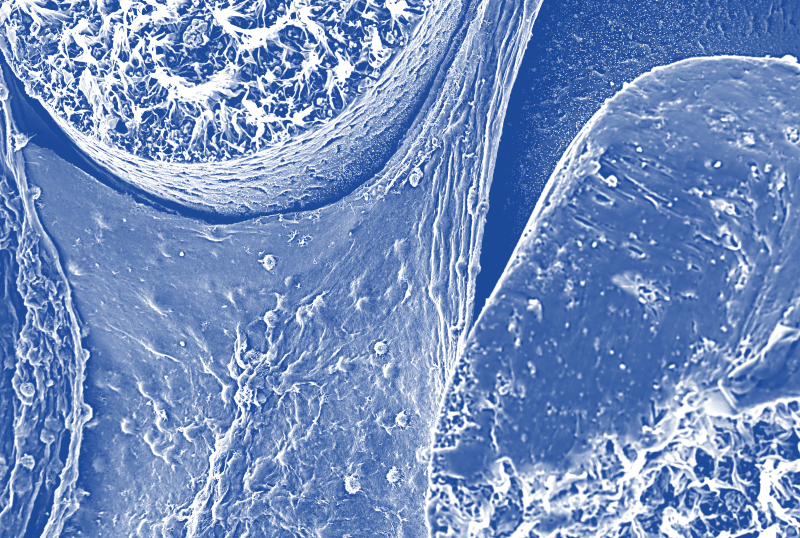Resources
Osteoinductive & Osteoconductive Biomaterials for Bone Defects: Insights into In Vitro Evaluation

Osteoinductive & osteoconductive biomaterials now play a crucial role in the treatment of traumatic, developmental, and pathological bone defects. Their purpose is to substitute or repair damaged bone. These biomaterials can be permanent or temporary and come in various forms, both natural (e.g., allografts and xenografts) and synthetic (e.g., alloplasts, metals, ceramics, polymers, and composites).
One crucial aspect of these biomaterials is their ability to fulfill specific functions, such as osteoinduction, osteoconduction, osseointegration, bioactivity, or mineralization. The effectiveness of these functions relies heavily on the material properties and the interaction between these biomaterials and the biological environment, such as protein adsorption and inflammatory processes. To accurately evaluate these biomaterials, comprehensive and precise in vitro methods within cell culture models are essential.
Expanding the Scope of In Vitro Testing
The outcomes of in vitro testing of osteoinductive & osteoconductive biomaterials can be significantly influenced by the testing conditions. In the pursuit of advancing research in bone disease pharmacokinetics and tissue engineering, the demand for reliable and appropriate cell culture models closely mirroring primary osteoblast cells is rising.
According to Fahimeh Tabatabaei, Study Director at iFyber, “cell lines differ substantially from primary osteoblast cells, and the choice of cell line significantly impacts the determination of biomaterial suitability. Thus, to improve the value of your biomaterial testing, it is crucial to consider multiple cell types and monitor temporal changes in gene and protein expression to avoid potential disparities between cell types.”
The Role of Osteoclasts in Biomaterial Development
While the study of bone formation using osteoblast precursors is extensively researched, the evaluation of bone resorption remains underappreciated in the context of osteoinductive & osteoconductive biomaterial development. Fahimeh explains, “osteoclasts and osteoblasts are critical participants in bone turnover, and their activities are closely interconnected throughout this process. Therefore, the best way to study bone formation and remodeling is with co-culture models involving both osteoblasts and osteoclasts that can replicate the dynamics observed in vivo.”
Fahimeh also highlights the importance of the degradation timeline of the biomaterial during bone healing “If the biomaterial is expected to degrade within three months after implantation, it may not be necessary to test the biomaterial in the presence of osteoclasts, as the degradation process would likely be complete by the time osteoclasts and osteoblasts initiate bone remodeling”.

Assessing Biomaterial Functionality
Once the appropriate cells and the method of interaction between cells and biomaterials are selected, it’s time to evaluate the functionality of the osteoinductive & osteoconductive biomaterial. Attributes such as bone conduction on implants and osteoinduction in biomaterials can be quantified with in vitro assays.
Fahimeh notes that these assays measure changes in cellular characteristics, including proliferation, migration, adhesion, and differentiation. Subcellular evaluations focus on intracellular signaling, gene expression, and metabolic pathways. Specific indicators such as alkaline phosphatase (ALP) and calcium mineralization are commonly used to gauge early osteoblast differentiation and final differentiation, respectively.
The success of both osteoconduction and osseointegration relies not only on biological factors but also on the interaction with foreign materials. “iFyber offers several options for evaluating cytokine release and gene expression in the presence of products,” says Fahimeh. “An essential characteristic of a clinically effective osteoinductive & osteoconductive biomaterial is its ability to withstand the initial stages of inflammation and facilitate the subsequent phases of bone healing. Consequently, it is crucial to assess the response of biomaterials to immune cells during their development, as this will shed light on how they may behave within the inflammatory environment in vivo.”
Advancements in In Vitro Testing of Osteoinductive & Osteoconductive Biomaterials: The Role of 3D Models
To bridge the gap between in vitro testing and physiological conditions, the development of 3D in vitro models has gained momentum. These models offer valuable insights into the microenvironment and its impact on biomaterial performance. Fahimeh points out that “at iFyber, our mission revolves around developing cutting-edge tools that enhance biomaterial evaluation and address clinical relevance. As part of our ongoing efforts, we are working on a new 3D model specifically designed to evaluate the osteoinductive & osteoconductive properties of our customers’ products”.
The evaluation of biomaterials for bone regeneration requires comprehensive and accurate testing methods. By expanding the scope of in vitro testing, incorporating osteoclasts, and assessing biomaterial functionality at multiple levels, researchers can deepen their understanding and drive improvements in clinical outcomes. iFyber’s commitment to innovation and its ongoing efforts in developing 3D models highlight its dedication to enhancing biomaterial evaluation and addressing real-world clinical relevance. With these advancements, the future of Osteoinductive & osteoconductive biomaterials for bone regeneration holds promise for more effective and successful treatments.

